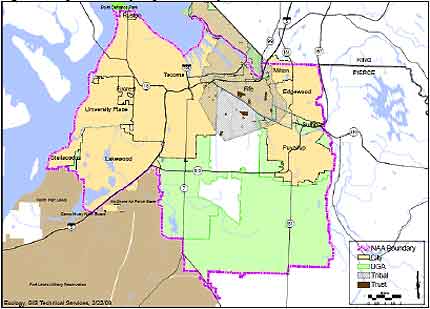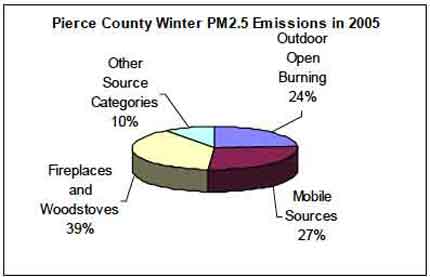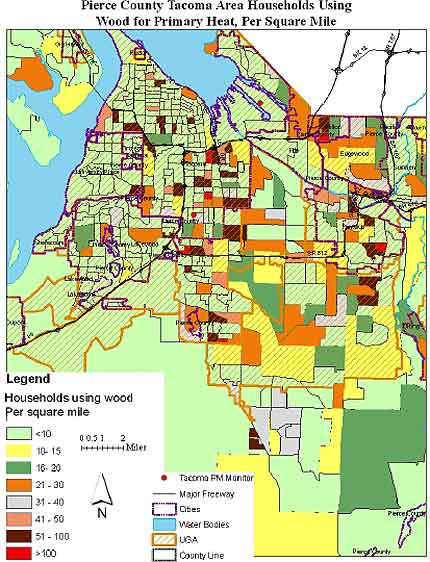|
Cartoons of
Dan McConnell
featuring
Tiny the Worm
Cartoons of
David Logan
The People's Comic
Cartoons of
John Jonik
Inking Truth to Power
|
Support the WA Free Press. Community journalism needs your readership and support. Please subscribe and/or donate.
posted Nov. 2, 2009
The purple border outlines the portion of Pierce County cited for pollution. It includes Tacoma, Puyallup, Fife, Milton, Lakewood, Edgewood, University Place, Steilacoom, as well as unincorporated areas.
The main culprit behind Pierce County pollution, according to the EPA, is home wood burning. “Mobile Sources” means emissions from motor vehicles. “Other sources” includes industrial emissions.
In some areas of Tacoma and vicinity, there are more than 100 households per square mile that primarily use wood for heating. It can be a very economical source of heat if one has a cheap or free source of firewood. Pierce County may have to develop incentives for households to use cleaner burning equipment.
![]()

Tacoma and NW Pierce Slapped for Particulate Pollution
Among five areas in the Northwest targeted by the EPA
by Doug Collins, including news release information from the EPA
The Environmental Protection Agency (EPA) in October designated five areas in the Pacific Northwest as “nonattainment” for fine particle air pollution, including Tacoma and northwest Pierce County (see map).
“Nonattainment” means that these areas do not meet federal standards for clean air.
EPA based the designations on air quality monitoring data from 2006 to 2008.
The five areas are:
• Part of Pierce County, Washington (including Tacoma and surrounding cities)
• Part of Klamath County, OR (Klamath Falls)
• Part of Lane County, OR (Oakridge)
• Part of the Fairbanks North Star Borough, AK (Fairbanks)
• Part of Franklin County, ID (Franklin)
Across the nation, 31 such nonattainment areas were designated.
According to Rick Albright, head of EPA’s air quality program in Seattle, these communities will need to develop their plans for reducing pollution by 2012 and demonstrate that they are meeting federal standards and are in “attainment” by fall of 2014.

“Research shows that fine particle pollution damages our lungs and compromises public health,” Albright said. “EPA is committed to assisting these communities so that they can get to work immediately to target the sources of pollution and safeguard public health.”
Regional EPA spokesperson Krishna Viswanathan says that a typical mitigation effort for an urban area like Tacoma involves the conversion of older wood stoves to modern, cleaner ones, as well as use of lower-sulfur fuels, but specific plans will be based on a detailed survey which has yet to be completed.
It should be noted that in the EPA’s ultimate analysis of the region, King and Snohomish counties also scored relatively high for particulate pollutants, roughly 75% the level of Pierce, but apparently not high enough to reach nonattainment status. According to Viswanathan, the EPA figures even take into account the pollution from SeaTac airport, which is generated in King County.
The five nonattainment areas in the Northwest and Alaska all have more air pollution problems in the winter from home heating sources including older wood stoves and oil furnaces.

In addition, during stagnant weather conditions with cold temperatures and limited air movement, pollution may “pool” in an area rather than dissipate. In some areas, vehicles and industrial sources also contribute to high wintertime particulate matter levels.
Visitors to summer campgrounds have undoubtedly noticed huge amounts of localized particulate pollution from dozens of bonfires on any busy evening, but EPA has apparently not taken any official look at this.
According to Viswanathan, EPA in most cases does not have direct enforcement authority over air pollution, but acts as an overseer of local programs to ensure compliance with the federal Clean Air Act.
EPA strengthened the 24-hour fine particle standard in 2006 to protect public health from harmful levels.
For more information about fine particulate pollution designations refer to http://www.epa.gov/pmdesignations
For the complete EPA report on Pierce County, click here.


